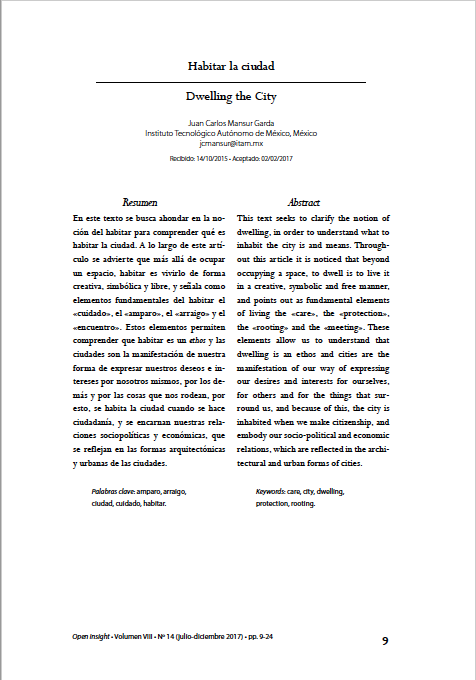Dwelling the City
Abstract
Received: 14/10/2015 • Accepted: 02/02/2017 This text seeks to clarify the notion of dwelling, in order to understand what to inhabit the city is and means. Throughout this article it is noticed that beyond occupying a space, to dwell is to live it in a creative, symbolic and free manner, and points out as fundamental elements of living the «care», the «protection», the «rooting» and the «meeting». These elements allow us to understand that dwelling is an ethos and cities are the manifestation of our way of expressing our desires and interests for ourselves, for others and for the things that surround us, and because of this, the city is inhabited when we make citizenship, and embody our socio-political and economic relations, which are reflected in the architectural and urban forms of cities.References
Danto, A. (2005). El abuso de la belleza. Estética y el concepto del arte, C. Roche, trad. Barcelona: Paidós Ibérica.
Gehl, J. (2006). La humanización del espacio urbano, M.T. Balcarce, trad. Barcelona: Reverté: Estudios Universitarios de Arquitectura 9.
Glaeser, E. (2011). El triunfo de las ciudades, F. Corriente, trad. México: Taurus.
Harvey, D. (2012). Ciudades Rebeldes, del derecho de la ciudad a la revolución urbana, J. Madariaga, trad. Madrid: Akal.
Heidegger, Martin: (1994). “Construir, Habitar, Pensar”. En Conferencias y artículos. Barcelona: Ediciones Serbal.
Jacobs, J. (1973). Muerte y vida de las grandes ciudades, A. Abad, trad. Barcelona: Península.
Ortega y Gasset, J. (1965) “En torno al Coloquio de Darmstadt, 1951”, O. C., VOL. IX, En Revista de Occidente 9.
Pallasmaa, J. (2016). Habitar. Barcelona: Editorial Gustavo Gili.
Pérez-Gómez, A. (2014). Lo bello y lo justo en la Arquitectura, A. Ortiz y S. de Orduña, trads. Colección Biblioteca. Xalapa: Universidad Veracruzana.
Solnit, R. (2015). Wanderlust. Una historia del caminar. Santiago de Chile: Hueders.





